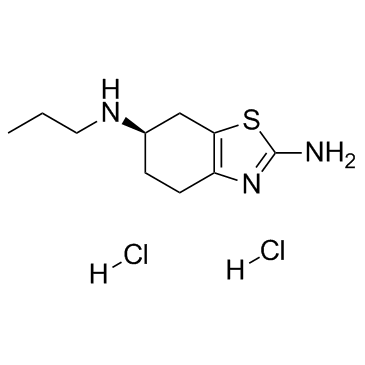Dexpramipexole (dihydrochloride)
Modify Date: 2024-01-02 14:08:56

Dexpramipexole (dihydrochloride) structure
|
Common Name | Dexpramipexole (dihydrochloride) | ||
|---|---|---|---|---|
| CAS Number | 104632-27-1 | Molecular Weight | 284.24900 | |
| Density | N/A | Boiling Point | N/A | |
| Molecular Formula | C10H19Cl2N3S | Melting Point | N/A | |
| MSDS | Chinese USA | Flash Point | N/A | |
| Symbol |

GHS07 |
Signal Word | Warning | |
Use of Dexpramipexole (dihydrochloride)Dexpramipexole 2Hcl(KNS-760704), also known as R-(+)-Pramipexole, is a neuroprotective agent and weak non-ergoline dopamine agonist. IC50 Value:Target: Dopamine ReceptorDexpramipexole has been found to have neuroprotective effects and is being investigated for treatment of amyotrophic lateral sclerosis (ALS). Dexpramipexole reduces mitochondrial reactive oxygen species (ROS) production, inhibits the activation of apoptotic pathways, and increase cell survival in response to a variety of neurotoxins and β-amyloid neurotoxicity. Compared to the S-(-) isomer, Dexpramipexole has much lower dopamine agonist activity. |
| Name | (6R)-6-N-propyl-4,5,6,7-tetrahydro-1,3-benzothiazole-2,6-diamine,dihydrochloride |
|---|---|
| Synonym | More Synonyms |
| Description | Dexpramipexole 2Hcl(KNS-760704), also known as R-(+)-Pramipexole, is a neuroprotective agent and weak non-ergoline dopamine agonist. IC50 Value:Target: Dopamine ReceptorDexpramipexole has been found to have neuroprotective effects and is being investigated for treatment of amyotrophic lateral sclerosis (ALS). Dexpramipexole reduces mitochondrial reactive oxygen species (ROS) production, inhibits the activation of apoptotic pathways, and increase cell survival in response to a variety of neurotoxins and β-amyloid neurotoxicity. Compared to the S-(-) isomer, Dexpramipexole has much lower dopamine agonist activity. |
|---|---|
| Related Catalog | |
| References |
| Molecular Formula | C10H19Cl2N3S |
|---|---|
| Molecular Weight | 284.24900 |
| Exact Mass | 283.06800 |
| PSA | 79.91000 |
| LogP | 3.50720 |
| Appearance of Characters | white to beige |
| Storage condition | ?20°C |
| Water Solubility | H2O: >15mg/mL |
| Symbol |

GHS07 |
|---|---|
| Signal Word | Warning |
| Hazard Statements | H315-H319-H335 |
| Precautionary Statements | P261-P305 + P351 + P338 |
| Hazard Codes | Xi |
| Risk Phrases | 36/37/38 |
| Safety Phrases | 26 |
| RIDADR | NONH for all modes of transport |
| (R)-N6-propyl-4,5,6,7-tetrahydrobenzo[d]thiazole-2,6-diamine dihydrochloride |
| (+)-2-amino-6-(propylamino)tetrahydrobenzothiazole dihydrochloride |
| (+)-Pramipexole dihydrochloride |
| (+)-2-amino-4,5,6,7-tetrahydro-6-L-propylaminobenzathiazole dihydrochloride |
| SND 919CL2x |
| 2,6-Benzothiazolediamine,4,5,6,7-tetrahydro-N6-propyl-,dihydrochloride,(R) |
| CS-1195 |
| Bio-0080 |
| UNII-I9038PKO43 |
| (-)-2-amino-6-propylamino-4,5,6,7-tetrahydrobenzothiazole dihydrochloride |
| Dexpramipexole (dihydrochloride) |